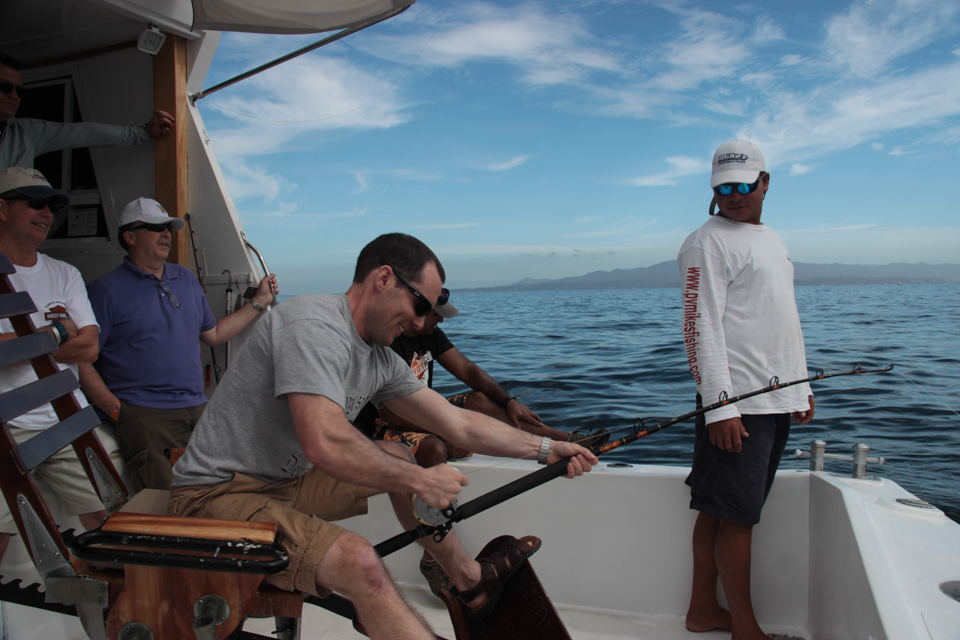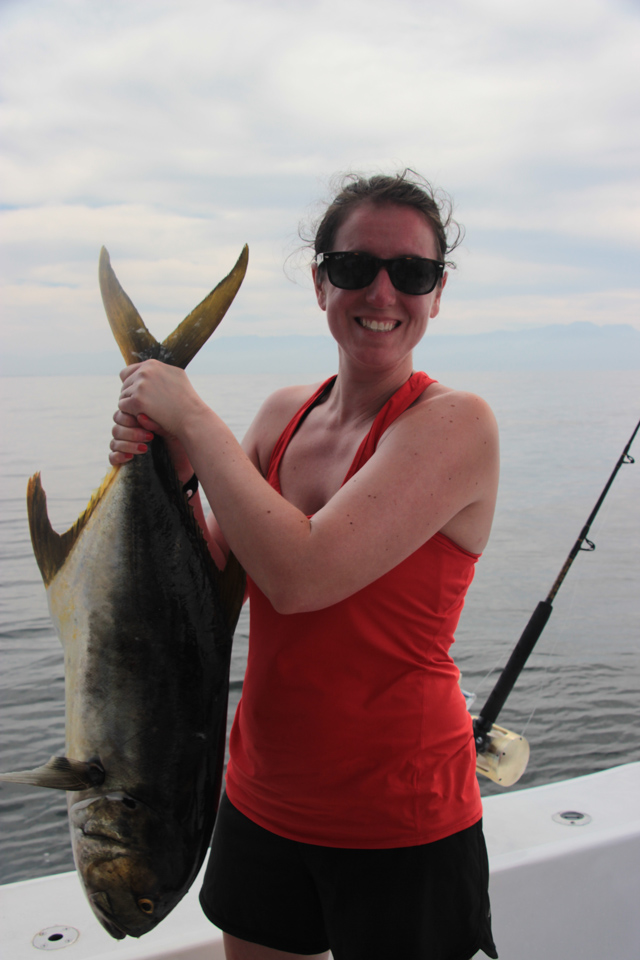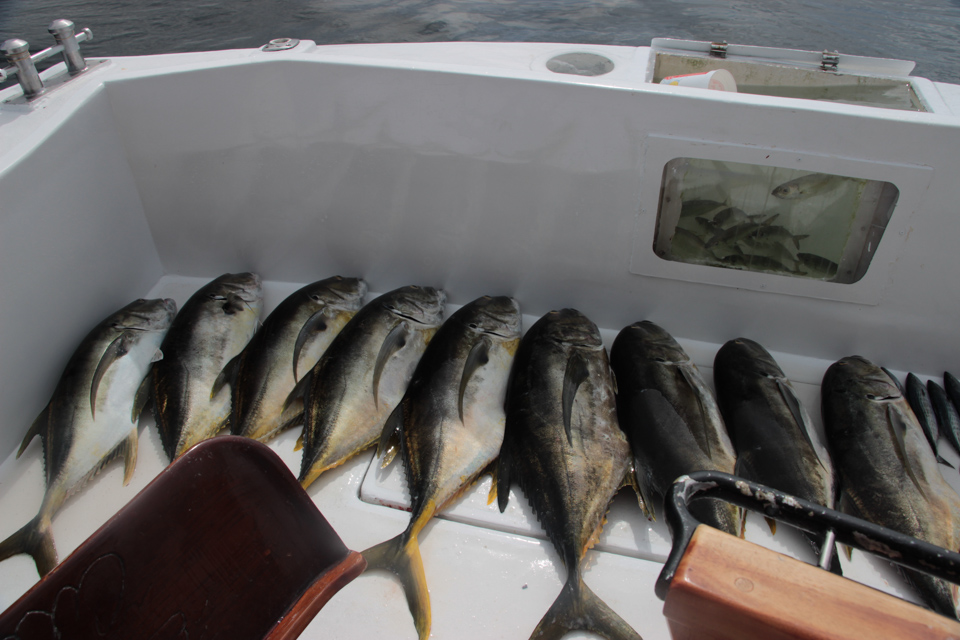“Fish on!” was called out across the boat. It was my turn in the fighting chair – 9th in a lineup of 9 on our charter in the Bay of Banderas. Everyone else had caught yellowfin tuna, so I was expecting that was what was on the line. But immediately it was clear this was something very different. The line on the spool started running – fast. The spool was at max tension, but it did nothing to slow this fish as it dove deeper and deeper. The two Mexican crew running the boat looked at each other and started speaking in Spanish, too fast for me to understand. El marlin negra – black marlin – is what they think was on the line.
Black marlin can grow to 10+ feet in length and hundreds of pounds – a whole different story than the 20-40 lb 3’ yellowfin tuna. The captain stopped the boat and they told me to go slow, a long fight was on my hands.
The fish kept running – 100 feet, 200 feet, maybe 300 feet of line spooled out. The line was going straight down, and was so tight you could play piano notes on it. As he kept running we started worrying the spool was going to run out of line. Finally he stopped and I worked hard to bring that line back in. It was a full body work-out pulling the rod up and then coming down, cranking the spool hard, repeated again and again.

Then the fish started running again, careening way off to the side, and the line started running out – losing 100-200 feet or so of my progress. At times I could only stop and rest, shaking my numbed arms to bring some life back into them. I was out of breath and drenched in sweat. This was more of a workout than I imagined fishing could possibly be.
Eventually I passed the torch to the next in the line-up – Natalie – and she fought the fish for a while. In the end, four different people took a turn, but as we were transferring to the 4th person, the marlin (we think) snapped the lead on the line, and we came up empty handed. It sure would’ve been great to see what it was. But, the experience was worth it in itself, and we had some delicious yellowfin tuna for dinner that night.

We’re in Puerto Vallarta currently, having gotten here the easy way – on a Boeing 737. This is our second time in PV together, and it always strikes such a sharp contrast to Seattle. The constant sun and heat, the cheap and delicious food, the simple way of life the locals here lead. While we have no plans to leave the PNW for sailing, Mexico is a special place.
Natalie was first in the lineup and caught a beautiful yellowfin tuna (and a bonito, which the boat caught a bunch of and made into ceviche).


The boat’s haul – 9 yellowfin tuna and a dozen bonito
Mexican Boats – A Picture of Necessity
It was interesting comparing the 46-foot fishing boat we were on to our boat. The fishing boat was clearly equipped precisely for its task – with no superfluous luxuries or expense. This is in stark contrast to most boats in the PNW. A single electronic display on our boat is more than the entirety of electronics on this boat. They have no chartplotter, no nav, no electronic speed displays. Of course no AIS, PLBs, or radar like many PNW boats consider essential. They navigated simply by experience, and if their engine overheats they grab a bucket of seawater and throw it in the hold. A screwdriver was jammed into the throttle to help hold it in place. No freshwater onboard, the fish are cleaned with seawater.
Admittedly a fishing boat is purposed towards a very different task than an ocean-going sailing vessel. But it was a reminder of how little is really necessary to have fun on the water, and also a reminder of how fortunate we are in the US with all our electronic gizmos.
Puget Sound Fishing
We learned some new fishing tricks, and hope to catch a salmon in Puget Sound or BC this year. The pelagic waters of Mexico also gave me an appreciation for how different it is here – the sea here seems teeming with life in comparison to the PNW. The PNW has fantastic sea life, but I would have to say the Bay of Banderas seems to have more. The boat caught 10 bonito (small fish good for ceviche) and 8-10 yellowfin tuna in the span of a couple hours. Later we saw a pod of dolphins – several dozen – leaping out of the water and swimming in our bow wake, and two manta rays.
In a way it made me sad for Puget Sound – the salmon population there is so low that some of the magnificent Orca whales are believed to be suffering from food scarcity. The salmon fishing season last year ended early and quotas were extremely restricted. The salmon are hurting because some of their spawning grounds have long been closed off by human-built dams which provide electricity that could just as easily be provided by lower-impact solar and wind power.
The town of Sayulita a short distance north of here dumps their sewage into the ocean because they don’t have adequate sanitation facilities to treat it. The US has much better environmental controls, yet Puget Sound recently had millions of gallons of sewage overflow into it due to a plant failure. So our problems are not that different.
Spending a lot of time on the water, we witness how resilient the ocean is, but also how important it is that we respect it.

Looks like fun. Too bad the “big one” got away. Reminds me of the time I caught a Chinook that was eaten by a seal and unknowingly played the seal, thinking it was a giant fish, until my arms were dead.
I enjoyed your interesting comparisons about Mexican mariners vs. PNW. I had a similar experience while on vacation in the Baja. Went fishing on a small Panga style commercial boat (commercial in the sense that the purpose was to catch fish to sell… it didn’t normally take people out pleasure fishing). It was a very memorable experience. The most exciting part was the way they launched boats into the giant waves off the beach. A ford bronco pushed the boat into the surf between waves. Then the boat in the ocean pulled the next boat in (slingshot style). It was crazy. The way we landed the boat was equally intense. We surfed in on a giant wave and beached the boat.
I’ve caught a lot of Salmon on the PNW with the help of experienced fisherman friends. It takes a lot of time, knowledge and gear. I’ve yet to catch anything on my sailboat. Even with all the gear it’d still be hard on my boat. Getting the trolling speed for Chinook/Kings (1.5kn) is hard with Diesel engines. Cohos/silvers may be a better target as one doesn’t need to go as deep or slow. Happy to share what I know if you’re keen to catch some salmon.
Wow, that story of the Ford Bronco push is crazy! I can definitely picture that in some of the smaller towns.
We’re always happy to hear salmon fishing tips. I think you might be right that it’s simply harder to catch salmon. Our Bay of Banderas boat was trolling at 3 to 6 knots. 1.5 kts on our sailboat is pretty hard to do consistently, and we’re probably often in the wrong spot. This summer we’ll be going up the west side part way (Ucluelet, Tofino areas).
Looking forward to reading of your summer west coast adventures. Great salmon and halibut fishing in those parts. I predict you’ll catch a salmon this year 🙂
I troll from my sailboat – downriggers are pretty essential for most of the year though. I used to do it under engine power but recently I’ve been experimenting with trolling under sail – it’s 100% doable. The trick is to just use the furling jib/genoa, that allows you to easily speed up/slow down depending on what the wind is doing. A beam reach is best as point doesn’t happen very well with just the headsail.
If you are wanting to get into salmon fishing, it’s a good time – the pink run is this year (they are every two years in these parts). Last run was HUGE so hopefully this year will be just as big. Pinks are close to the surface so you can either troll using slip weights or jog for them, meaning you don’t need a downrigger. They also eat ANYTHING, basically.
As for the salmon populations – it’s complicated. Some are under severe pressure (fraser river sockeye), some aren’t doing great (south island chinook) and some populations seem to be thriving (pinks). Fish farms seem to be a unifying factor in places where the runs are a lot less.
Thanks! Why do you say downriggers are pretty essential for most of the year? Because the non-pink salmon species are down deep? Can’t we get the lure deep by trolling slowly (< 2 kts) and putting out a lot of line? Keep in mind we're fishing neophytes who have no clue about these things. 🙂 Just trying to figure out what we're doing wrong.
Unfortunately pink salmon are the least tasty. We're spoiled by the availability of delicious sockeye, chinook and king, and see pink as good only for smoking. Maybe it's better when fresh caught than grocery-store-bought though.
Yup – the only salmon that are around year round are springs/chinook/kings (same species, different names!) and they are RIGHT on the bottom usually. To get that deep you need a downrigger – just putting a lure out will get you to 20 feet at the most. Using a slipweight you can probably get to around 50 foot.
In the summer, all the species come close to shore to feed before they head up river (the salmon run), and a lot of them are closer to the surface. Coho you can often catch by dragging a lure across the surface!
And that’s exactly it – pink’s flesh is a lot more delicate than other salmon types, and it starts to turn to mush right after death. You have to put it in a cooler right after you catch one – and they really don’t freeze very well at all, and nowhere near as well as the more robust springs/coho/sockeye, though if you freeze it right after you catch it then that helps. But in a grocery store – you have no idea how long the fish sat out before it was frozen. Even an hour in the sun is enough to destroy the flesh.
But fresh, with some lemon juice and pepper – they are delicious. And one fish is a perfect sized meal for two!
Yeah, a downrigger and heavy cannon ball are needed to get deep enough for Springs. A deep six trolling diver can get line down but I’ve had trouble with the action they create on the rod.
While you’re in Ucluelet, going out on a fishing charter might be worth a look (to learn how it’s done). When I’ve gone on a charter there I’ve caught and frozen/packaged enough fish to pay for the cost. Might be hard to store on a sailboat tho.
Matt, what kind of downrigger do you use on your sailboat? Seems they’re a bit expensive and require a mounting, so it’s a bit of an investment. How heavy of a cannonball are we talking?
Jr, re: deep six trolling diver creating issues – YES! We used one of those and it made it really hard to get it back in, at anything over 1 kt of boat movement.
My friend uses 15lb cannon balls on his Boston Whaler in Howe Sound.
I’ve a pair of Scotty 1106s that I got on sale on Boxing Day. Pricey yeah, but I fish a lot. They are removable so live in my sail locker most of the time. I use a 10lb ball on each. 200ft is about the deepest I go.
Agree with JR a fishing charter would be fun and very instructive! Also if you are ever in my area I’ll take you out.
I meant 12lb, not 10